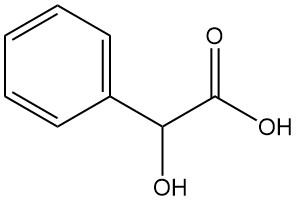
Glyoxylic acid, also known as oxoacetic acid, is the simplest α-oxocarboxylic acid with the formula C2H2O3. It is a colorless solid that is present in plants and plays an important role in animal metabolic cycles.
Its discovery dates back to 1856 when Debus established its formula. Perkin later provided a more precise description of the monohydrate formula in 1868.
Kronberg and Krebs elucidated the fundamental aspects of the metabolic cycle of glyoxylic acid in 1957.
This cycle operates as a relay in the tricarboxylic acid cycle during specific plant life conditions such as germination or ineffective photosynthesis. In this cycle, isocitrate is anaerobically converted to malate.
Therefore, glyoxylic acid is an essential metabolic intermediate that contributes to plant and animal physiology.
Table of Contents
1. Production of Glyoxylic acid
Glyoxylic acid is synthesized industrially through the oxidation of glyoxal in aqueous solution with 65% nitric acid in mole ratios of 1:1 to 1:1.5 within the temperature range of 40 to 90°C.
The byproduct of this reaction is oxalic acid, which can be separated through low-temperature crystallization.
To purify the solution, it can be passed through an anion-exchange resin or electrodialysis can be used to remove the residual nitric acid.
An alternative method involves the oxidation of glyoxal at the anode of a two-compartment electrolytic cell in the presence of chloride ion.
Catalytic oxidation of ethylene or acetaldehyde can also be used to synthesize glyoxylic acid, but these routes have not been widely used in industry due to their low selectivity.
The cathodic reduction of oxalic acid provides a good chemical yield (85%), but lead electrode passivation can cause issues with this method.
Finally, glyoxylic acid can be produced through the oxidative cleavage of maleic acid or its esters using ozone. This method has been adapted for the preparation of hemiacetal esters.
2. Chemical Reactions of Glyoxylic acid
Glyoxylic acid possesses two functional groups, the carbonyl group that undergoes reactions distinctive of aldehydes, and the carboxylic acid group. The hydrated aldehyde and the hemiacetal react similarly with nucleophilic reagents.
Intramolecular ring formation can occur with ambident nucleophiles reacting with the carboxylic group. Polynucleophiles can be coupled with glyoxylic acid to obtain various heterocyclic compounds, such as 2-hydroxyquinoxaline and allantoin.
Heating causes glyoxylic acid to disproportionates to a mixture of glycolic acid and oxalic acid, and it can be easily oxidized to oxalic acid by nitric acid.
The Mannich reaction and amidoalkylation are industrial reactions that employ glyoxylic acid.
At slightly alkaline pH, glyoxylic acid reacts with amides such as acrylamide to form acrylamidoglycolic acid (AGA), which is utilized as a copolymerizable cross-linking agent. AGA and its derivatives have found industrial applications in coatings and paint for automobiles.
With phenol, glyoxylic acid can be used in the synthesis of 4-hydroxymandelic acid and benzaldehydes.
Glyoxylic acid can also undergo aldol reaction to produce benzoylacrylic acids.
Esterification of glyoxylic acid can result in polymerization under the action of a base, and the resulting polymers exhibit useful chelating properties with the advantage of good biodegradability.
Glyoxylic acid finds application in the synthesis of N,N’-ethylenebis[2-(2-hydroxyphenyl)glycine] (EHPG), an iron(III) complex-forming agent, and 4-hydroxyphenylglycine, an intermediate for the semisynthetic penicillin amoxicillin.
Additionally, it reacts with phenol and ammonia to produce 4-hydroxyphenylglycine. Glyoxylic acid and hydrochloric acid are used to chloroalkylate aromatic compounds.
Glyoxylic acid, when reacted with thiophene, yields 2-thienylacetic acid, which is used to prepare the semisynthetic cephalosporins cephalothin and cefoxitin.
Finally, low molecular mass polyglyoxylates have been proposed as replacements for sodium tripolyphosphates (TPP) in detergents to control water hardness.
Reference
- Glyoxylic Acid; Ullmann’s Encyclopedia of Industrial Chemistry. – https://onlinelibrary.wiley.com/doi/10.1002/14356007.a12_495




